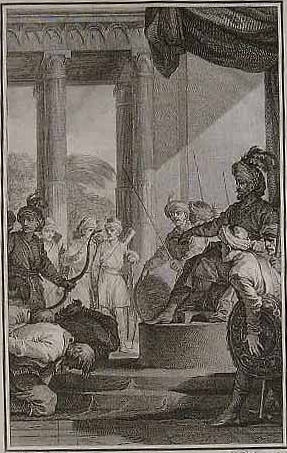Anglo-Mughal War (1686–1690) facts for kids
Quick facts for kids Anglo-Mughal War |
|||||||
|---|---|---|---|---|---|---|---|
| Part of Anglo-Indian Wars | |||||||
 French illustration of Sir Josiah Child requesting a pardon from the Emperor Aurangzeb |
|||||||
|
|||||||
| Belligerents | |||||||
| Mughal Empire | |||||||
| Commanders and leaders | |||||||
|
|
||||||
| Strength | |||||||
|
Total
|
Total
Siege of Bombay
|
||||||
| Casualties and losses | |||||||
|
Bombay
Madras Unknown, likely all |
Total Light to none |
||||||
The Anglo-Mughal War, also known as Child's War, was the first major conflict between the English East India Company and the powerful Mughal Empire in India. This war happened between 1686 and 1690.
The English East India Company was a strong trading group from Britain. They had special rights to trade in India and many forts along the coasts of the Mughal Empire. These rights were given by the British King and allowed by local Mughal governors.
In 1682, a Company representative named William Hedges was sent to talk with Shaista Khan, the Mughal governor of Bengal. The Company wanted an official order, called a firman, from the Mughal Emperor Aurangzeb. This order would let them trade freely across all Mughal lands.
However, Sir Josiah Child, who was a powerful leader in the East India Company in London, caused problems in the talks. Because of this, the Mughal Emperor Aurangzeb stopped the negotiations.
Contents
Why Did the War Start?
In 1685, the governor of Bengal increased taxes on trade from 2% to 3.5%. The East India Company refused to pay these new taxes. Sir Josiah Child then decided that the Company should go to war against the Mughals.
The Company wanted to control the important Hooghly River and capture the city of Chittagong. They hoped to create their own strong area and become independent from the Mughal Empire in that region. They also wanted to make friends with the Kingdom of Mrauk U in Arakan (modern-day Myanmar) to gain more power in the Bay of Bengal.
King James II of England sent warships to help the East India Company in India. But this plan did not work out well.
Key Events of the War
After the warships arrived, several battles took place. The English tried to blockade Mughal ports and even captured ships carrying Muslim pilgrims going to Mecca.
Early Battles and Blockades
In 1685, Admiral Nicholson was sent with twelve warships and 600 soldiers. His orders were to capture and fortify Chittagong. He also planned to take control of the surrounding land and make a treaty with the ruler of Arakan.
However, the fleet got separated during the journey. Some ships ended up in the Hooghly River instead of going to Chittagong. English troops from Madras joined them there.
The arrival of such a large English force worried Shaista Khan, the Mughal governor. He offered to make peace. But an unexpected event stopped the talks. Three English soldiers got into a fight with Mughal officials in the marketplace of Hooghly and were badly beaten. In response, Admiral Nicholson sent troops to capture the town.
In 1686, new peace talks began. But the Mughals purposely made the talks last longer. This gave them time to gather their troops to attack the English camp. The English commander, Job Charnock, moved his soldiers to a swampy island called Ingelee. This island was unhealthy, and within three months, half of the English troops died from disease.
Mughal Response and English Defeat
In 1688, an English fleet blocked Mughal ports on India's western coast in the Arabian Sea. They even captured merchant ships carrying Muslim pilgrims on their way to Mecca. When Emperor Aurangzeb heard about this blockade, he decided to restart peace talks with the English.
However, the Company sent more troops led by Captain Heath. He ignored the peace treaty that was being discussed. He sailed to Balasore and attacked it, but he was not successful. Then he went to Chittagong, but its defenses were too strong. So, he landed his forces in Madras.
After these actions, Emperor Aurangzeb ordered his forces to take over all East India Company properties across India. He also ordered their goods to be seized. As a result, the East India Company was left with only two fortified towns: Madras and Mumbai (Bombay).
In 1689, a strong Mughal fleet from Janjira, led by Sidi Yaqub, blocked the East India Company fort in Bombay. After a year of fighting, a famine (severe lack of food) broke out because of the blockade. The Company had to surrender.
In 1690, the East India Company sent representatives to Emperor Aurangzeb's court. They begged for forgiveness and asked to restart their trading rights. The Company's envoys had to bow down before the Emperor. They also had to pay a very large fine of 1,500,000 rupees (which would be about $4.4 million today). They also promised to behave better in the future.
Emperor Aurangzeb then ordered Sidi Yaqub to end the siege of Bombay. After this, the East India Company was able to set up their base again in Bombay and also started a new trading post in Calcutta.

See also
- Henry Every
- Thomas Tew
- Battle of Buxar

